Embrace the Harvest: Your Ultimate Guide to Delicious and Nutritious Fall Vegetables
As the vibrant hues of summer fade, a magical transformation sweeps across the landscape, heralding the arrival of autumn. The air turns crisp, inviting cozy sweaters and comforting aromas. For food lovers and health enthusiasts alike, this season brings an abundance of nature’s finest: a spectacular array of fall vegetables. This is the perfect time to transition from lighter summer produce to hearty, nutrient-packed delights that truly thrive in cooler weather.
Whether you’re an experienced home cook, a dedicated gardener, or simply enjoy exploring the treasures at your local farmers’ market, the autumn harvest offers something truly special for everyone. Join us as we uncover the incredible world of seasonal vegetables waiting to enrich your plates and nourish your body this fall.
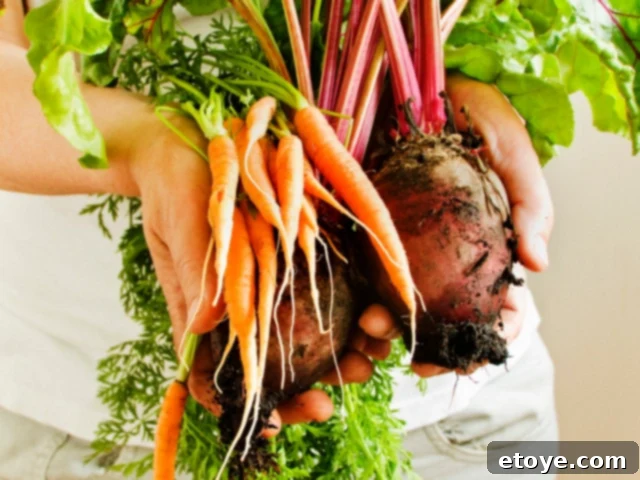
What’s Ripe and Ready: Discovering Fall’s Seasonal Bounty
Curious about what delicious produce is in season during the glorious fall harvest? Prepare to be delighted! This time of year sees a thriving collection of root vegetables, including earthy carrots, versatile turnips, and naturally sweet potatoes, all of which embrace cooler temperatures with ease. Alongside these subterranean gems, you’ll find an impressive selection of cruciferous vegetables like crunchy Brussels sprouts, vibrant broccoli, and adaptable cauliflower. Don’t forget the power-packed leafy greens such as robust kale, tender collard greens, and colorful Swiss chard. For many of these incredible vegetables, a touch of light frost even enhances their flavor, making them sweeter and more complex.
Let’s take a closer look at some of these in-season superstars, delving into their nutritional benefits and exploring countless ways to incorporate them into your autumn culinary adventures.
Cruciferous Vegetable Powerhouses
Brussels Sprouts: A Comeback King

Once famously disliked by picky eaters, these miniature cabbages have undergone a remarkable culinary renaissance in recent years. The secret? It’s all in the preparation! Roasting them to crispy perfection with a drizzle of olive oil, a sprinkle of sea salt, and perhaps a touch of maple syrup for a delightful caramelized finish transforms their flavor. You can elevate them further by adding smoky bacon bits for a savory punch or shredding them raw into fresh salads for an unexpected crunch and peppery zest.
Your body will certainly thank you for embracing Brussels sprouts. They are a nutritional powerhouse, brimming with essential nutrients like vitamins C and K, which are vital for a strong immune system and robust bone health. Beyond that, they’re an excellent source of powerful antioxidants and boast a high fiber content, crucial for healthy digestion and a reduced risk of various chronic diseases. Their unique flavor profile and impressive health benefits make them a must-have on any fall menu.
Looking for a fantastic way to enjoy them? Explore our enticing recipe for Roasted Brussels Sprouts With Cranberry Pistachio Pesto for an unforgettable side dish!
Broccoli: The Green Giant of Good Health
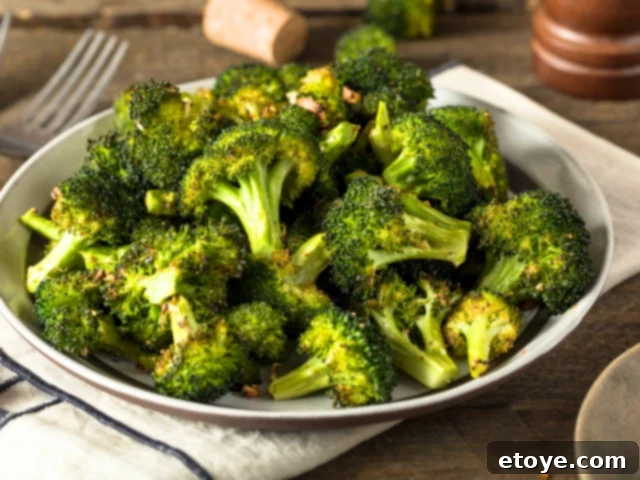
Ah, broccoli – the quintessential vegetable many of us grew up with, often encouraged by our parents to finish every last bite. And for excellent reason! From a health perspective, broccoli is a true nutritional champion. Much like its cousin, Brussels sprouts, it offers an abundance of vitamins C and K, along with important minerals such as potassium, calcium, and iron. Broccoli is also exceptionally rich in dietary fiber, which aids digestion and promotes satiety. Furthermore, it contains potent antioxidants like sulforaphane, a compound extensively studied for its potential role in lowering the risk of certain cancers. As an added bonus, it’s a fantastic source of folate, which plays a crucial role in supporting brain health and cognitive function.
Culinary applications for broccoli are incredibly diverse. Roasting it brings out a wonderfully nutty and slightly sweet flavor, especially when paired with olive oil, minced garlic, or a refreshing squeeze of fresh lemon juice. It’s equally delicious when steamed to tender-crisp perfection as a simple side, stir-fried alongside other seasonal vegetables, or tossed into pasta dishes for a quick and nutritious weeknight dinner. For a touch of elegance and warmth, blending it into a creamy broccoli soup creates a cozy and satisfying meal perfect for cooler evenings.
Craving an effortless method to prepare broccoli? Check out our Steamed Broccoli In The Microwave post for a super-fast and easy technique!
Cauliflower: The Versatile Chameleon

Few vegetables have witnessed such a dramatic rise in popularity and versatility as cauliflower in recent years. Its mild flavor and adaptable texture have made it a culinary chameleon, capable of transforming into an astonishing array of dishes. It serves as an excellent low-carb alternative to mashed potatoes, can be riced for grain-free meals, or even used to create innovative vegan substitutes for classic dishes like buffalo wings. Perhaps most surprisingly, it can be crafted into a delicious and sturdy pizza crust! Roasting cauliflower is a fantastic way to enhance its naturally slightly sweet and nutty flavor, especially when tossed with olive oil and your favorite aromatic spices like smoked paprika, cumin, or turmeric.
Being a close botanical relative to broccoli, cauliflower shares many of its impressive health benefits. It’s packed with vitamins, minerals, and antioxidants, while being remarkably low in calories. This combination makes it an ideal swap-out for less healthy ingredients in various recipes, or simply a nutritious and satisfying vegetable to enjoy on its own. Its ability to absorb flavors makes it a chef’s dream, allowing for endless creative culinary explorations this autumn.
Earthy Delights: Root Vegetables
Sweet Potatoes: The Naturally Sweet & Wholesome Spud

Root vegetables are unique in their ability to store vital energy within their roots, making them naturally rich in complex carbohydrates, dietary fiber, and a treasure trove of essential vitamins and minerals. Sweet potatoes are a prime example of this natural abundance. These delightful tubers are particularly renowned for their high content of beta-carotene, a powerful antioxidant that the body converts into vitamin A. This nutrient is crucial for supporting excellent eye health and giving a significant boost to your immune system, especially important as cooler weather approaches. They also provide valuable fiber for healthy digestion, potassium for blood pressure regulation, and vitamin C, all contributing to your overall well-being and vitality.
Culinary possibilities for sweet potatoes are virtually endless. You can mash them into a creamy side dish, roast them to bring out their natural sugars, or transform them into beloved sweet potato fries or comforting pies. Whether savory or sweet, there’s truly no wrong way to savor these delicious and nutritious spuds.
Carrots: Crunchy, Sweet, and Vision-Boosting

This sweet, crunchy, and vibrant darling of the root vegetable family is incredibly versatile. Carrots are excellent for snacking raw, adding a delightful crispness to salads when shredded, or roasting to intensify their inherent sweetness. You can elevate their flavor further by glazing them with a touch of honey or maple syrup for an irresistibly addictive side dish, or tossing them into hearty soups and stews to add depth and a hint of natural sweetness. Beyond savory applications, carrots are a surprising yet delicious ingredient in baked goods, lending moisture and flavor to classics like carrot cake or muffins. They are indeed quite the versatile treat!
Carrots are famously rich in beta-carotene (yes, we couldn’t resist the pun!), which your body efficiently converts into vitamin A. This essential vitamin is not only crucial for maintaining optimal eye health and sharp vision but also contributes to glowing skin. Furthermore, carrots are packed with various antioxidants that help protect your cells against damage from free radicals. They also offer a significant boost of vitamin K, vital for blood clotting and bone health, and potassium, which supports healthy blood pressure and overall cardiovascular wellness.
Turnips: The Underrated Root with a Zesty Kick
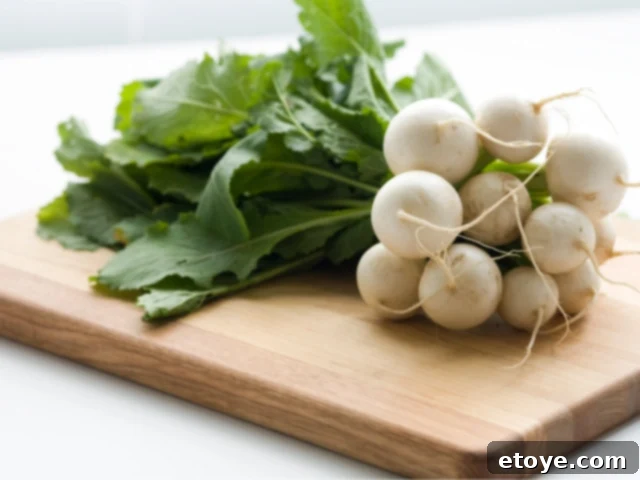
Let’s be honest: turnips often don’t receive the same enthusiastic attention as their root vegetable counterparts, but they absolutely should! Their distinctive peppery flavor provides a unique and intriguing kick to a variety of dishes. They blend beautifully into creamy mashed potatoes, adding an unexpected layer of flavor, and roast up magnificently when tossed with a little olive oil, salt, and your favorite fresh herbs. Turnips are a fantastic addition to warming soups, hearty stews, and comforting casseroles, where their robust flavor can truly shine. For a fresh and spicy boost, you can even enjoy them raw, thinly sliced or grated into salads.
Beyond their culinary appeal, turnips are also remarkably nutritious and impressively low in calories. Their generous vitamin C content provides a significant boost to the immune system, helping to ward off seasonal sniffles, and promotes healthy skin. Meanwhile, their potassium content plays a vital role in regulating blood pressure, contributing to overall cardiovascular health. Don’t overlook this humble yet powerful root vegetable this autumn!
Vibrant Vitality: Leafy Greens
Swiss Chard: A Rainbow of Nutrients
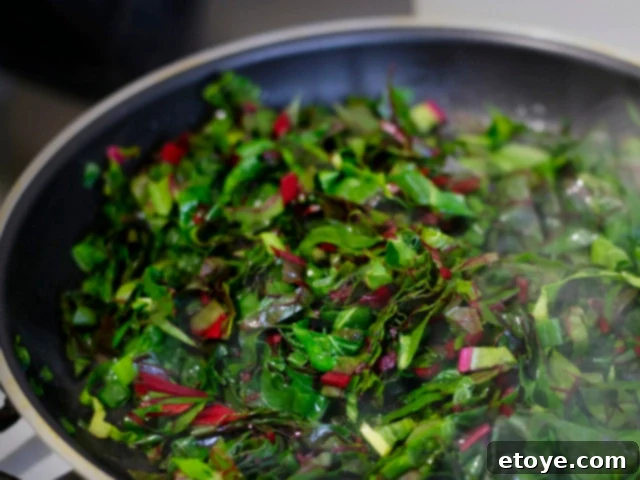
With its striking bright red, yellow, and orange stems contrasting against dark green leaves, Swiss chard is as visually appealing as it is nutritious. It makes for a quick and incredibly easy side dish when simply sautéed with olive oil and garlic, a method that perfectly highlights its slightly earthy flavor. Swiss chard is also a fantastic addition to soups and stews, instantly boosting their nutrient profile. Incorporate it into stir-fries for added texture and color, mix it into frittatas or quiches for a wholesome meal, or creatively use its large, sturdy leaves as wraps for a delicious low-carb alternative to traditional tortillas.
However you choose to enjoy it, Swiss chard delivers an impressive array of vitamins A, C, and K, which are fundamental for excellent eye health, robust immune function, and strong, healthy bones. It’s also a significant source of magnesium and potassium, minerals essential for regulating blood pressure and supporting overall heart health. Furthermore, Swiss chard is high in fiber, promoting healthy digestion, and its rich antioxidant content helps to reduce inflammation and offers protection against various chronic diseases. Truly a leafy green superstar!
Kale: The Uncontested Superfood
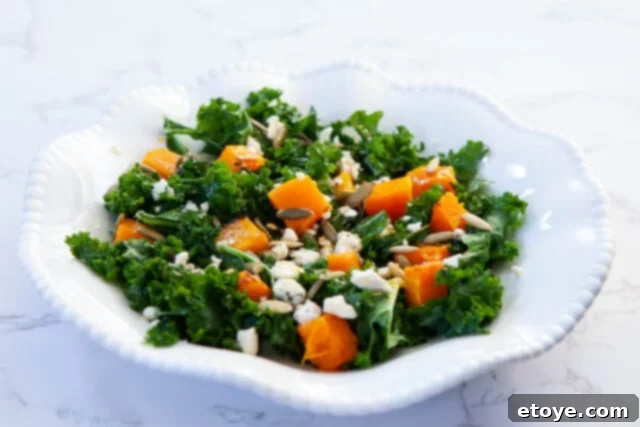
Kale has long been revered as a ‘superfood,’ and for very good reason. Its versatility in the kitchen is matched only by its incredible nutritional density. It can be massaged with olive oil to create a tender, flavorful base for salads, baked into irresistibly crispy kale chips for a healthy snack, or blended into smoothies for an instant nutrient boost. Beyond its culinary adaptability, kale is jam-packed with essential vitamins A, C, and K, along with a significant amount of calcium, making it exceptionally beneficial for bone health. It’s also loaded with powerful antioxidants that actively fight inflammation throughout the body and contains beneficial compounds like sulforaphane, which have been extensively researched for their potential role in cancer prevention.
Seeking more innovative ways to enjoy this amazing leafy green? Sauté it with garlic and a squeeze of fresh lemon for a simple yet elegant side, add it to your favorite soups for added heartiness, or blend it into a unique pesto for a vibrant and nutrient-rich sauce that can elevate any dish.
Collard Greens: A Southern Comfort & Health Staple
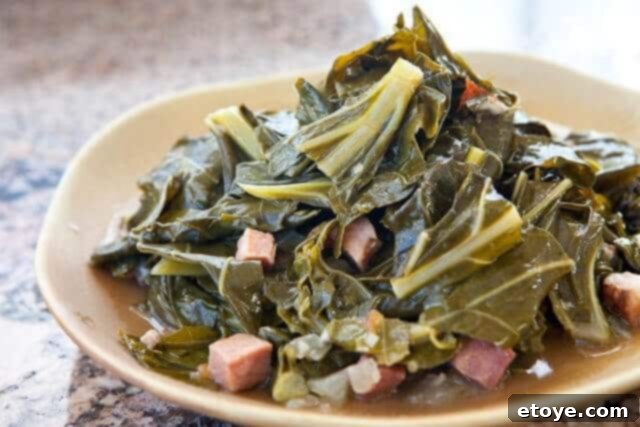
A cherished Southern staple, collard greens truly deserve a prominent spot on every autumn table. Traditionally braised slowly with savory bacon or smoked meat until fork-tender, they develop a rich, complex flavor. However, their culinary applications extend far beyond this classic preparation. They are equally delicious when quickly sautéed with garlic for a lighter side dish or ingeniously used as sturdy, edible wraps, providing a wholesome, low-carb alternative to tortillas. Their inherently hearty texture makes them an excellent addition to robust soups, warming stews, and even comforting casseroles, where they impart a subtle, earthy, and often buttery flavor that enhances the entire dish.
The health benefits of collard greens are truly exceptional! They are exceptionally rich in vitamins A, C, and K, supporting everything from clear vision and strong bone density to a robust immune system. Their substantial fiber content helps you feel fuller for longer, aiding in weight management and promoting digestive health. Furthermore, they are chock-full of calcium, making them an especially valuable vegetable for maintaining strong bones and teeth, particularly for those seeking plant-based calcium sources.
Butternut Squash: The Quintessential Taste of Autumn

No exploration of autumnal vegetables would be complete without celebrating the beloved butternut squash. This quintessential winter squash embodies the very essence of comfort and flavor for the season. Its distinctively sweet and nutty profile makes it incredibly versatile and utterly delicious, whether pureed into silky smooth soups, roasted to perfection, or even creatively stuffed into ravioli for an elevated meal. Butternut squash is a nutritional powerhouse, packed with vitamin A (in the form of beta-carotene), essential potassium, and beneficial dietary fiber. It’s also a fantastic low-calorie option for providing satiety and energy without weighing you down. For a quick, warming, and intensely flavorful dish that captures the spirit of autumn, simply roast cubes of butternut squash with olive oil, fresh sage, and a delicate dash of cinnamon – it’s pure seasonal bliss.
When to Buy What: Your Seasonal Shopping Guide
Fall truly is the prime season for cool-weather crops, and making your produce purchases at the optimal time ensures you’re enjoying vegetables at their peak flavor, nutritional value, and freshness. Use this factual guideline to navigate the autumn harvest and make sure you’re getting the best fall vegetables at the perfect moment!
Early Fall (September to Early October)
These early autumn vegetables are at their absolute best when the weather begins to cool gently, but before the first significant frosts arrive. They thrive in mild conditions:
- Broccoli: Crisp and vibrant, with tightly packed florets.
- Cauliflower: Firm, white heads, often sweeter than in warmer months.
- Green Beans: Still widely available, carrying over their crispness from the late summer harvest.
- Swiss Chard: Tender leaves and vibrant stems, excellent for sautéing.
- Brussels Sprouts: Small and firm, often sweeter than those harvested later.
- Cabbage: Firm, dense heads perfect for slaws or roasting.
- Leafy Greens: (like spinach and arugula) Tender and flavorful before intense cold sets in.
Mid-Fall (October to Early November)
As the days grow shorter and the air becomes noticeably cooler, these hearty vegetables reach their peak flavor, often developing a deeper sweetness and more complex profiles:
- Carrots: Extra sweet and crunchy, ideal for roasting or raw snacking.
- Beets: Earthy and sweet, perfect for roasting, boiling, or pickling.
- Turnips: A fantastic peppery kick, enhanced by the cooler weather.
- Sweet Potatoes: Richly flavored and wonderfully sweet, ready for all your comforting recipes.
- Kale: (especially good right after a light frost) Frost makes the leaves sweeter and more tender.
- Pumpkins: Perfect for carving, decorating, and, of course, delicious pies and savory dishes.
- Butternut Squash: Fully matured, deeply flavorful, and versatile.
- Collard Greens: Hearty and robust, their flavor profile deepens beautifully.
- Radishes: Crisp and peppery, offering a fresh contrast.
Late Fall (November to Early December)
As the frost truly settles in and temperatures drop significantly, these robust, enduring vegetables hit their stride, offering deep flavors and excellent storage qualities:
- Parsnips: Sweet, earthy, and fantastic for roasting, mashing, or adding to stews.
- Rutabagas: A delightful cross between a turnip and cabbage, with a slightly sweet, earthy flavor.
- Leeks: Mildly oniony and sweet, perfect for soups, stews, and gratins.
- Celery Root (Celeriac): A wonderfully nutty and earthy root, excellent mashed or roasted.
- Winter Squash: (including acorn, spaghetti, and kabocha) These varieties are fully mature, offering dense flesh and long storage capabilities.
Fall Fruits: A Sweet Addition (All Autumn Long)
While our focus is on vegetables, we can’t resist throwing in some delightful fall fruits because everyone loves a touch of natural sweetness to complement their meals!
- Apples: Peak season begins in early fall and continues through late fall, offering countless varieties for eating, baking, and cider.
- Pears: Best in early to mid-fall, with varieties ranging from crisp to buttery soft.
- Cranberries: Available fresh in late fall, perfect for sauces, baking, and festive dishes.
Smart Storage Solutions: Keeping Your Fall Vegetables Fresh
Mastering proper storage techniques is key to extending the life of your precious fall veggies, ensuring you get the most out of their flavor and nutrients. Here’s a comprehensive guide on how to store them effectively.

Essential Tips for Storing Fall Vegetables:
- Root Vegetables (Carrots, Beets, Turnips, Parsnips):
- Storage: These resilient crops prefer a cool, dark, and slightly humid environment. The crisper drawer of your refrigerator is ideal. Crucially, always remove any leafy green tops before storing, as these greens continue to draw moisture from the root, causing them to wilt and spoil faster.
- Shelf Life: When stored correctly, root vegetables can last anywhere from several weeks to a few months, depending on the variety and storage conditions.
- Bonus Tip: For longer-term storage without refrigeration, packing them in slightly moist sand, peat moss, or sawdust in a cold, unheated garage or root cellar can keep them fresh for even longer periods.
- Winter Squash (Butternut, Acorn, Spaghetti, Pumpkin):
- Storage: These thick-skinned beauties prefer a cool, dry place at room temperature, away from direct sunlight. Before storing, ensure they are fully “cured” – meaning their skin is hard and unblemished, which helps them last longer.
- Shelf Life: Properly cured and stored winter squash can last an impressive 3 months or even longer.
- Bonus Tip: Regularly inspect your stored squash for any soft spots, blemishes, or signs of mold. Use any affected squash immediately to prevent spoilage from spreading to the others.
- Brussels Sprouts:
- Storage: Store unwashed Brussels sprouts in the crisper drawer of your refrigerator. If purchased on the stalk, leaving them attached will significantly extend their freshness. Otherwise, store individual sprouts loosely in a breathable bag.
- Shelf Life: Typically, Brussels sprouts will remain fresh for 1 to 2 weeks in the refrigerator.
- Bonus Tip: If you buy them on the stalk, simply snap off sprouts as you need them. This method keeps them fresher for a longer duration.
- Leafy Greens (Kale, Swiss Chard, Collard Greens):
- Storage: The key to fresh leafy greens is moisture without sogginess. Wrap them loosely in a slightly damp paper towel, then place them in a breathable plastic bag (or a container designed for greens) in your fridge’s crisper drawer. Avoid packing them too tightly or placing heavy items on top, which can crush them.
- Shelf Life: With proper storage, most leafy greens can stay fresh for at least a week, and often up to 10 days.
- Bonus Tip: If your greens start to look a bit limp or wilted, a quick 15-30 minute soak in a bowl of cold water (perhaps with an ice cube or two) can often revive their crispness and texture.
- Cabbage, Cauliflower, and Broccoli:
- Storage: These cruciferous vegetables need good air circulation. Store them in the refrigerator, ideally in perforated plastic bags or loosely wrapped in plastic to maintain some humidity while allowing airflow.
- Shelf Life: Whole heads of cabbage are quite robust and can last up to a month. Cauliflower and broccoli, being a bit more delicate, typically last 1 to 2 weeks.
- Bonus Tip: Never wash these vegetables before storing them! Excess moisture trapped on their surface can accelerate spoilage and promote mold growth. Wash only right before you are ready to use them.
- Celery Root (Celeriac):
- Storage: This unique root vegetable thrives in cool, dry conditions. Store it in a cool pantry or, more commonly, in your refrigerator, wrapped loosely in plastic or placed in a plastic bag to prevent it from drying out.
- Shelf Life: Celery root can last for a good 3 to 4 weeks in the refrigerator.
- Bonus Tip: If your celery root comes with leafy green tops, cut them off before storing. Similar to other root vegetables, the greens will draw moisture away from the root, diminishing its quality and shelf life.
More Autumn Inspiration: Recipes & Tips to Explore
Looking for even more ways to celebrate the fall season? Dive into these fantastic articles and recipes:
- 5 Healthy Fall Buddha Bowls
- Vegetable Quinoa Pilaf with Honey Mustard Chicken Recipe
- How To Make Vegetables Last Longer
Fall Into the Flavorful Season!
While the warmth of summer certainly has its charms, the fall season generously offers us an unparalleled abundance of unique, healthy, and incredibly versatile vegetables. These autumn gems are not only delicious but also packed with the nutrients our bodies crave as the weather cools. From the comforting earthiness of root vegetables to the vibrant crunch of leafy greens and the delightful sweetness of winter squash, there’s an endless array of flavors and textures to explore. What are your go-to dishes this time of year? Which fall produce item holds a special place in your heart (or on your plate)? We’d absolutely love to hear about your autumnal culinary favorites! Be sure to leave a comment below and share what you cherish most about these wonderful fall vegetables.
